Made it to Nairobi

Nairobi Airport & time for Shaun’s ride; swag bag and spare tyres loaded up for the ride back to Jungle Junction. Fortunately, it wasn’t raining.
Saturday 28 April and we’re on schedule for Shaun to join the road team and take a ride. He’s due in for next Wednesday 3 May carrying a bagful of spare parts including a couple of rear tyres. We figured that the original coming-in tyres would last from Cape Town to Nairobi, and they have – just. We could have done with that additional traction on the really muddy stretches around Dodoma in Central Tanzania.
From the relative emptiness of the East African bush then to East Africa’s largest city; in reality the commercial centre of the region. There are an estimated four million people living here – and they all seemed to be on the road at the same time as we arrived. The power of Nairobi’s economy is tough on the other national capitals in the region, but that’s what history and being the larger and fastest-on-your-feet does for you. It also has distinct drawbacks for the quality of life of those at the bottom of the social heap. Kenya is relatively rich when compared to the other East African countries but, in a population estimated 40 million (and counting), you have to believe that the majority rural people will eventually end up in the urban centres seeking their role within the development lifestyles that they regularly see on local television. Everyone chases their dreams – and if this is not practical where you are, then the young leave their elders behind and head for the cities.

Nairobi City; once the safari capital of the world, now simply an African city anywhere in Africa. Modern highrise looking rough around the edges close up, and this thing about those social divisions between rich minorities and poor masses.
Nairobi
You can see this riding into Nairobi – passing the extensive areas of slum housing on the main Nairobi-Mombasa road. This is where many of the newcomers end up. There is none of the planned social segregation seen with urban development in Nairobi when compared to the countries further south, with the city overflowing with squatters and poor housing wherever there is government land to be occupied. Nairobi is home to one of Africa’s largest and most notorious slums in Kibera to the west of the city. Slum areas occupy an estimated 10% of the city’s area, but provide home for >50% of local people. The contrast with the leafy – security fenced – neighbourhoods elsewhere in the city – home to the rich and the rapidly rising middle classes – could not be more marked; this thing about social inequality between the different groups.

Jungle Junction. Home from home in Nairobi; where all the serious cross-Africa travellers stay. Rain season and cold, but all those facilties, all those people and all that information available; a place not to be missed.
And this reflects in the security of people in the city, for Nairobi is infamous for the insecurity of the streets, urban violence, house burglary and more. You walk the streets at peril of being mugged – people of all shades of colour and all kinds of dress. Most tourists are shepherded into and out of the main city airport into their safari wagons for their sanitized holidays in ‘bush land’. It never used to be like this – and security is better than it was just 10-years earlier with increased police and private security guards everywhere, but you still don’t place yourself at risk by casual wandering around this city. Count the shops with armed security guards outside on the pavement/entrance.
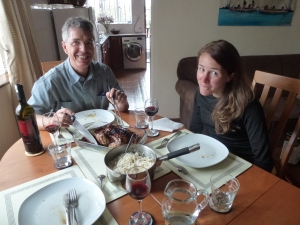
Meet JJ – meaning JJ Franc de Ferriere – Franco-Kiwi par excellence and currently managing a project in support of agro-business development in Kenya. Networks were alive and buoyant; sharing a meal chez lui.
The city owes its existence to the construction of the Mombasa-Kampala railway by the British colonial administration just over 100 years ago – it was the location of a materials depot at a halfway point along the line of rail, access to a plentiful supply of water and at an elevation that provided for more comfortable living conditions for managers and workers. From here-on westwards, the line of rail climbs into the highlands that formed the basis for colonial agriculture that – post-independence in 1963 – continues to dominate a large part of the national economy through to the present day.
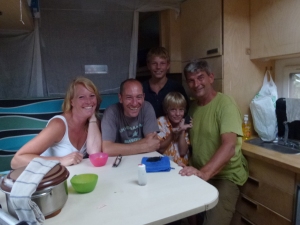
Fellow travellers – Family Arkesteijn; we met them in Nairobi and eventually kept pace with them all the way to Aswan. We’ll introduce them later.
Nairobi as a name is derived from the language of the Maasai people who originally grazed cattle in the area, and it means the ‘Place of cool waters’. We passed many groups of these largely nomadic people grazing livestock alongside the road when travelling from Arusha to Nairobi, but you would have to squint through those rose-tinted glasses to imagine their time during the 19th century and earlier. The Kikuyu people have come to embrace the modern Kenya and have risen to national dominance on their ability to adapt and change. The Maasai have remained traditional in outlook and lifestyles – and have not.
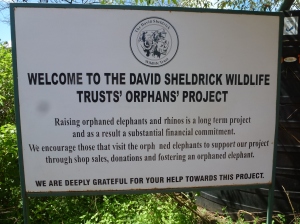
An ‘Arican Love Story’ of the very best kind; rescuing orphan elephants and rhinos left behind by poachers. Read more at: http://www.sheldrickwildlifetrust.com
Challenge of city riding
Just riding the roads into the city becomes a challenge – probably the worst urban riding of the journey so far – well, we’ve really only experienced the relatively well-designed and managed cities of the south; and, by comparison with Asia – West Africa even, all have been small; little more than towns (well, apart from Cape Town). We complained earlier about the traffic grid-lock in Lusaka – it’s nothing compared to this most romantic sounding of East African cities – Nairobi; but then this is probably that thing about learning about countries and the people who live there from the television and movie spectaculars. The reality can be quite different. I have to say, we rounded off our biking skills with enthusiasm – filtering and weaving the traffic in Nairobi on our way to the Jungle Junction Overland Lodge.
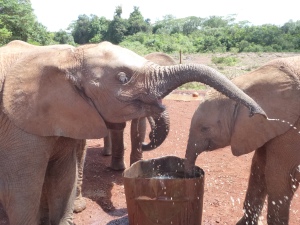
Baby anythings are always attractive; and this is what the crowds come to see each day – baby elephant walks. Elsewhere you can see the baby rhinos. Get there quick, Africa is no longer one wide open game range.
Time for some TLC – people and bikes
We were both well covered with the characteristic red mud/dust roads we travelled on in Tanzania – with just about every item of clothing and all our camping gear really dirty. More than that, however, the blue bike has been playing up again. It has a bit of a cough – well it struggles to supply sufficient fuel at >50 mph, so we crawled through the traffic in Nairobi following the SATNAV directions to the lodge. We are all in need of some rest and attention. Kristian will change the oil and filters on the bikes for the second time of the journey too, and if Shaun has those tyres we’ve planned for they’ll be fitted to the bikes.
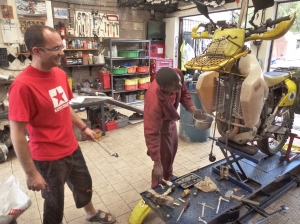
JJ has just about the best m/bike workshop in Africa; the place is owned by an ex-BMW mechanic and has trained staff on hand. Just the place to give the bikes the once-over.
Heading off to London
I depart tomorrow Sunday 29 April just before midnight and arrive at Heathrow early the next day with just sufficient time to head straight to the office. Sure, I’ve a change of clothes in my locker and there’s a shower available. This is going to be one surreal environmental change for me – for the trip has been amazing and a wonderful adventure/experience that everyone should do!! I shall be sad to leave it all behind, and especially Kristian.
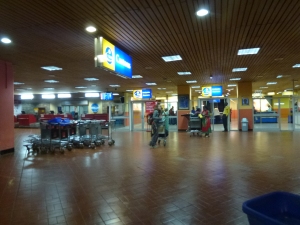
Anna doing her usual survey of African airports; to add to her knowledge of African roads. Next stop Addis Ababa.
We’ve been pretty sloppy with the blog, but we’ve kept a regular diary and have our stories prepared – and hope to update everything here at Jungle Junction and/or when I get back to London. Kristian may also have some time on hand before Shaun arrives to add his views, but this pre-supposes that he’s completed the basic R&M that may be possible before Wednesday and Shaun’s arrival. It’ll probably take them another day or so after Wednesday to change the tyres, oil, etc. Then there’s the unknown issue of the interrupted fuel supply on the blue bike to explore (and solve). The ride north to the Ethiopian border takes in the most difficult and isolated stretch of the entire journey – hard roads, irregular traffic and a reputation for bandits at times. Can’t have the bike playing up on that stretch; and there’s no real alternative R&M centre before Addis Ababa – which is probably a week or 10 days away. Fortunately, workshop facilities here at Jungle Junction are really good.
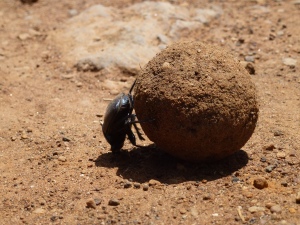
And, if you thought that all the wildlife was large and dominating – think again. This little critter was pushing his/her young down the side of the road; in a ball several times his/her size. Imagine the effort and instincts involved.
Steele Family
Nairobi
01 May 2012

Leave a comment